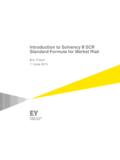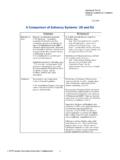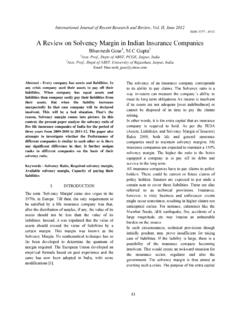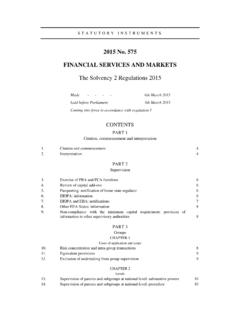Transcription of Treatment of captives in SOLVENCY II - ECIROA
1 Position paper on Treatment of captives in SOLVENCY II Position Paper 2 1 2 NATURE AND RATIONALE OF Captive 3 THE SOLVENCY II EU OBJECTIVE 1: Improve protection of policyholders and EU OBJECTIVE 2: Improve international competitiveness of EU EU OBJECTIVE 3: Deepen integration of the EU insurance 4 EXECUTIVE PILLAR PILLAR PILLAR Position Paper 3 1 Introduction With SOLVENCY II, the EU Commission aims to have a framework applicable to everyone. However, the arguments and facts presented in this paper substantiate the necessity to apply the principle of proportionality to smaller (re)insurance corporations ( smaller either by business activity, policy volume or premium value), such as captives . captives do not compete for market share on the open insurance market as do commercial (re)insurers. The complex rules of SOLVENCY II could discourage groups from forming new captives and could trigger a redomiciliation of existing captives to outside of the EU.
2 captives are (re)insurance companies and as such they should have the same rights and obligations, however simplifications should be made. The challenge is to ensure that the special Treatment of captives under SOLVENCY II will not have an impact on the commercial insurers and reinsurers involved in the captives insurance programmes, in a way that penalises them compared to non-EU (re)insurers. We would welcome the opportunity to work with supervisors and other stakeholders on further developing the detail of the simplifications for captives within the directive with respect to Pillar I, Pillar II and Pillar III issues. 2 Nature and Rationale of captives A captive (re)insurance company is an affiliate created or owned by industrial, commercial or financial groups, the purpose of which is to (re)insure all or part of the risks of the group it belongs to. Coverage is implemented on the basis of guidelines issued by group management.
3 The design of a captive structure is based on the understanding that (with this instrument) an internationally operating corporation is optimising its own risk transfer, primarily by carrying part of the risk, after diligent assessment and based on their own (and other market participant s) past losses and claims experience. The Risk Management departments of major industrial, commercial or financial groups are dealing with questions such as: (i) What are our risks? (ii) Should we retain or not retain those risks? (iii) How should we finance those risks? Understanding and managing the risks (taking into account the objectives of the enterprise in a proactive way) is a real strategic challenge. Captive Objectives The motivations of an enterprise to create a captive are numerous and can vary considerably from one group to another, depending on its objectives, its location and its activities. a) Reduction or stabilisation of insurance premiums at group level captives are generally used to smooth out the impact of swings in insurance costs which follow hardening/softening markets.
4 The managers of group subsidiaries are responsible for delivering set returns on target. The use of a captive will enable enterprises to consider the global economic situation of the group and will allow the group to benefit from the mutualisation of its risks. In addition, it can obtain better conditions by Position Paper 4 transferring a global risk portfolio to the market and can achieve increased power in negotiations with the insurance market. b) Benefiting from a good risk management The captive enables the group to preserve the benefits of its underwriting policy. On one hand, because the parent company can retain risks with a good loss ratio within the captive and on the other hand because the captive can generate a potential reduction of premiums. By having a captive, the company s insurance premium will be priced based on the group s own loss experience and will be less impacted by the downgrading of the loss experience of other insured parties.
5 In addition, the group will gain an advantage from its risk prevention and management measures. c) Optimisation of financial flows linked to risk management Some risks cannot be transferred to the insurance market and are a threat to the profit and loss and balance sheet of the group. By using a captive, the group can protect its balance sheet by setting up technical reserves for future losses within the insurance accounting of the captive. In addition, the captive is able to retain the return on accumulated funds. This return is lost when premiums are paid to a commercial insurer. d) Solution to market inadequacies During hard market periods, companies may find it difficult to get the cover they require for certain risks. They may even be met with reductions in limits, increased deductibles and refusals from insurance companies to cover these risks. The captive provides the group with tailor-made covers that can compensate for these inadequacies, for example through implementing a specialised insurance wording where the market standard is not sufficient.
6 E) Direct access to worldwide professional reinsurers Direct access to the reinsurance market reduces the number of intermediaries, diminishes the frictional costs and facilities the establishment of long-term and stable partnerships. In addition, the terms offered by the reinsurance market are generally more competitive (as structural costs are lower for reinsurers than for direct insurers) and the premiums required are specifically adapted to each client. The group could also have the possibility to implement long-term programs with some reinsurers. f) Better control of risk management A captive simplifies the centralisation of worldwide insurance programs and the gathering of information regarding risks. It enables risks to be managed at group level and guarantees a better risk awareness at operational level and an increased transparency of insurance-related costs. Having a captive provides management with a greater focus and a more strategic approach towards risk retention, risk capital allocation and risk tolerance.
7 Position Paper 5 3 The SOLVENCY II objectives captives usually have a simple risk structure compared to a commercial (re)insurance undertaking. We therefore believe that supervisors should develop a different and more appropriate supervisory approach to captives taking into consideration their nature and purpose This should not be linked to the size of the captive but to the nature, scale and/or complexity of the risks supported via the captive structure. EU OBJECTIVE 1: Improve protection of policyholders and beneficiaries This objective has limited applicability to captives , since the original policyholder of an insurance captive is normally also its owner. This applies also indirectly to reinsurance captives . The goal of customer protection to secure policyholders, individuals (private lines) as well as commercial corperations or big international enterprises, will not be impacted by captives .
8 Neither a single captive nor a group/community of captives may have a chance to produce a crisis or a significant impact on the whole insurance system. Systemic risk is therefore not relevant. This is a good reason why the rules for captives should be simplified. The arguments against each sub-objective of SOLVENCY II (a-e) below further support why there should be an introduction of special captive rules within the SOLVENCY II framework. a) Align capital requirements with the underlying risks of an insurance company I. A captive is usually an integrated part of its owner s risk management programme. II. As mentioned above, the rules should take into account the size, nature and complexity of the captive. The nature of the risks is similar to that of a commercial (re)insurer but the degree and diversity of exposure differ substantially. captives do not have a portfolio of different policyholders, but instead have a limited number of policies per line of insurance to optimise the risk transfer strategy of their corporate group.
9 III. captives normally have a good knowledge of reported claims since their owner is the only claimant and do not need to use actuarial evaluations of market experience etc. to properly establish their ultimate net loss reserves. IV. captives do not compete with the financial markets as commercial insurers may. V. Corporations use their captives to manage the group s transferable risks. b) Maintain strong, effective insurance protection while achieving optimal capital allocation Some of the peculiarities of captives directly affect their SOLVENCY requirements under SOLVENCY II in a negative way. For example: I. Concentration of assets. For a captive it is not always appropriate to hold a diversified portfolio of investments. Therefore captives sometimes pool part of their accumulated funds with one or two banks. Position Paper 6 II. Often the captives insurance portfolios are limited to a few lines of business, thus causing a lack of diversification.
10 It is a special feature of captives to underwrite just some lines of business. This is one of the reasons why fronting insurers diligently use insurance and finance experts to check the structure of the underwritten portfolio and the technical provisions. III. A captive writing a single line, or a few lines of business has the potential for high claims volatility. Unlike commercial insurers captives do not have stable portfolios or homogeneous risks. A limited portfolio and a low number of transactions will result in actuarial computations that are statistically unreliable. Statistical volatility will lead to volatility in the level of capital. IV. Significantly, captives are calculating more conservatively compared to commercial insurers, especially in structuring their reinsurance agreements. captives typically have a combined ratio lower than 100% and very often have an annual aggregate limit within their contracts.




